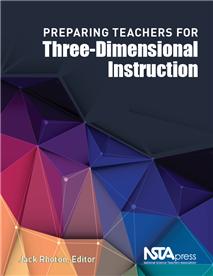From Vision to Reality: Making the NGSS Come Alive in Every Classroom
By Carole Hayward
Posted on 2018-04-16
 The Next Generation Science Standards (NGSS) are ushering in an exciting new era of science education where three-dimensional learning integrates core ideas, science and engineering practices, and crosscutting concepts to deliver an education that prepares today’s students to become “effective, rational thinkers able to contribute to (and cope with) our complex and constantly changing societies,” writes Bruce Alberts in the foreword to NSTA’s new book, Preparing Teachers for Three-Dimensional Instruction.
The Next Generation Science Standards (NGSS) are ushering in an exciting new era of science education where three-dimensional learning integrates core ideas, science and engineering practices, and crosscutting concepts to deliver an education that prepares today’s students to become “effective, rational thinkers able to contribute to (and cope with) our complex and constantly changing societies,” writes Bruce Alberts in the foreword to NSTA’s new book, Preparing Teachers for Three-Dimensional Instruction.
Alberts, who serves as the Chancellor’s Leadership Chair for Science and Education at the University of California, San Francisco and is the President Emeritus of the National Academy of Sciences, acknowledges that the NGSS require substantial shifts in the way preservice science teachers are trained as well as to the professional development practicing science educators receive so that science educators can empower their students to become effective problem solvers who make wise decisions for ‘themselves, their families, and their nation.”
While the book’s primary audience is preservice education teachers, science education faculty and practicing K-12 science educators will also benefit from reading it. The instructional practices that K-12 science educators are using to unlock the vision behind the NGSS as well as the shifts being made to the entire field of science education—by higher education science faculty, science teachers, teacher education faculty, and others—are showcased in this book.
Five major sections organize the book’s 18 chapters which are written by outstanding classroom teachers and science educators at all levels:
Section 1
Shifts in Teacher Knowledge and Practice: Models of Teaching to Meet the Intent of the NGSS
Some of the nation’s most outstanding science teachers share how they are using three-dimensional strategies in their classrooms as they transition their teaching of science from inquiry to science as practice. NGSS-aligned curriculum planning and methods of assessment are also addressed in this section.
Section 2
Professional Development Strategies That Support the Implementation of the Framework and the NGSS
Examples of professional development strategies to help K-12 science teachers address specific subject matter as well as proven instructional activities that promote critical thinking and depth of understanding are covered in this section.
Section 3
Teacher Preparation Courses for Preservice Teachers
The nation’s future science teachers need to be equipped with the knowledge and tools to design lessons, assessing students, implement strategies, and evaluate outcomes. This section discusses ways higher education faculty are supporting future teachers’ understanding of three-dimensional learning by giving them opportunities to build capacities and demonstrate their knowledge as they construct explanations, analyze and interpret data, develop models, and engage in argumentation from evidence.
Section 4
Undergraduate Science Course for Preservice Science Teachers
Future science teachers cannot embrace the paradigm shift called for by the NGSS if they have never seen models of context and content in their undergraduate science courses as well as in their teacher education preparation programs. Higher education instructors, in this section, describe some of the changes they made as well as the challenges they have encountered in revamping their teaching techniques.
Section 5
Epilogue: Three-Dimensional Instruction Beyond the Classroom
Teachers know that it takes business-education partnerships to ensure that K-12 students are obtaining the skills and knowledge they need for success in higher education and the workplace. This section explores the work of East Tennessee State University’s (ETSU) Center of Excellence in Mathematics and Science Education as well as ETSU Northeast Tennessee STEM Hub. Guidance is also provided in this section for leaders to use in forming new partnerships, establishing shared goals, and encouraging ongoing contributions to meet those shared goals.
Book editor Jack Rhoton, in the preface, acknowledges the “daunting, complex, and time-consuming task” of fully implementing the vision of the NGSS.
“There is no magic wand for achieving the vision. Instead, educators will need to apply a variety of approaches and efforts over an extended period of time. We believe that the contents of this volume will serve as a motivating resource for the science education community that helps them to harness skills, expertise, and passion as they look to revitalize science instruction.”
Read the free sample chapter to learn how the authors engaged preservice teachers in evidence-based augmentation and helped them assess their own science content knowledge, augmentation skills, and ability to plan instructional activities centered on augmentation.
Making the vision of the NGSS come alive in every K-12 science education classroom will take more than teachers just reading the new standards and aligning their content to the curriculum. This book supports students in becoming true practitioners of science by supporting the transition away from formulaic classroom instruction that far too many students continue to experience.
This book is also available as an e-book.
Follow NSTA

